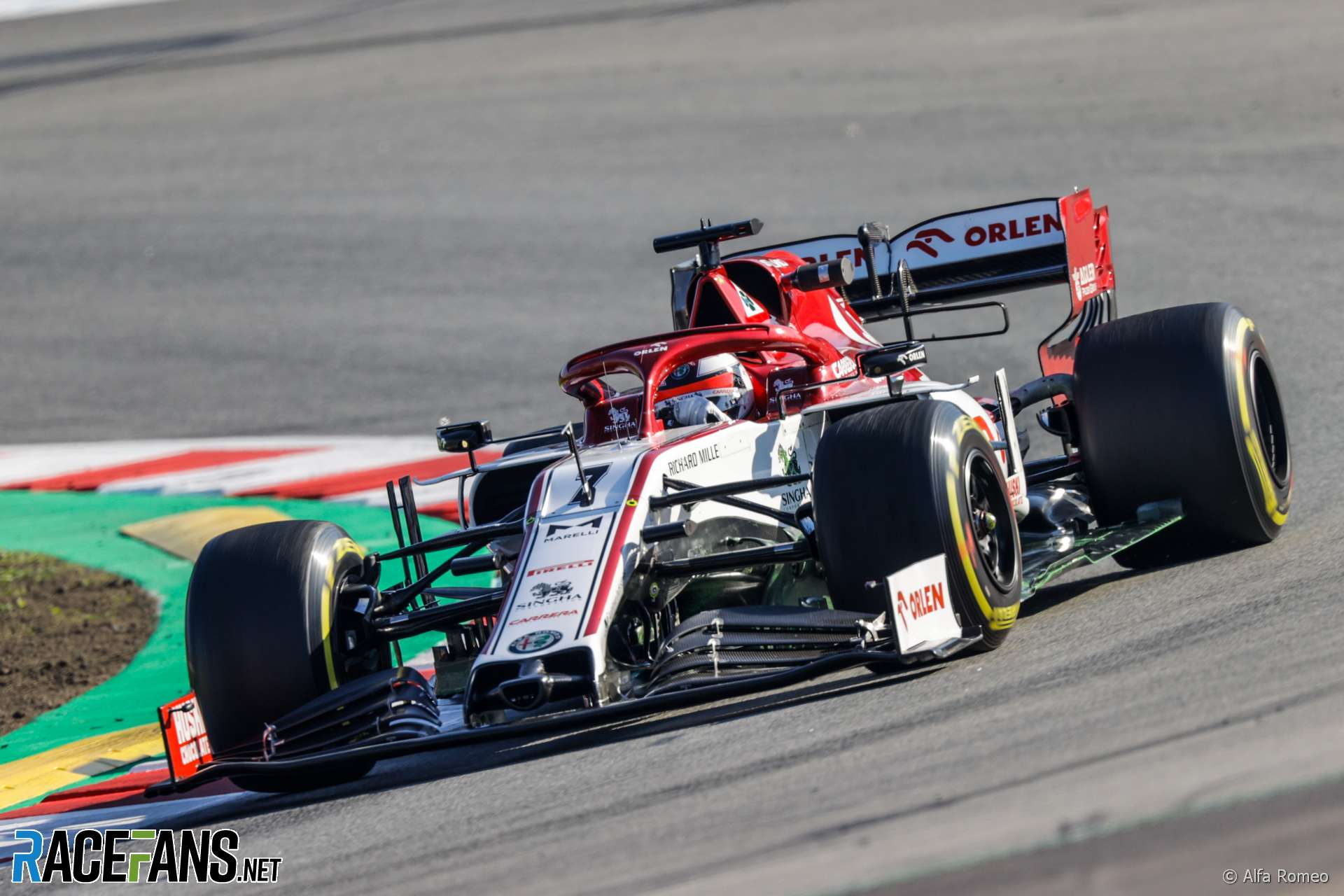The minimum car weight limit will rise again in the 2021 F1 season, despite teams having agreed to carry over their current chassis into next year.
RaceFans has learned the minimum weight limit will rise from 746kg to 749kg in 2021.The latest rise in the minimum weight limit follows concerns raised by some engine manufacturers that the pursuit of weight savings could lead them to introduce more exotic and expensive materials. Some teams also expressed fears they could not get their designs down to the current minimum weight limit.
Many leading drivers have repeatedly complained about the rising weight of F1 cars which have already gained more than 100 kilograms in seven years – a rise of more than 16% since the end of the V8 engine era.
A kilo was added to the minimum car weight this year to allow teams to fit a second, encrypted FIA fuel flow meter.
F1 car weights are due to increase even further in 2022 when new technical regulations originally intended for next season come into force. As RaceFans revealed in February this is due to stronger crash tests being introduced, which will require larger impact-absorbing structures on the cars. This could push minimum weights as high as 778kg in 2022.
Formula 1 managing director Ross Brawn said last year he was “frustrated” by complaints over the rising weight of F1 cars. “We’d all love the cars to be lighter,” he said, adding, “there are some things we can’t turn the clock back on.”
Advert | Become a RaceFans supporter and
F1’s minimum weight limit, 1961 – 2021
NB. Separate minimum weight limits for turbocharged and normally aspirated cars were set in 1987 and 1988.
What other rules changes is Formula 1 planning for 2020 and 2021 – and why? Read the new RacingLines column later today on RaceFans to find out
Don't miss anything new from RaceFans
Follow RaceFans on social media:
Advert | Become a RaceFans supporter and
2021 F1 season
- Verdict on error in GT race suggests Mercedes would have lost 2021 Abu Dhabi GP appeal
- Title ‘stolen’ from Mercedes made us ‘underdogs people cheer for’ – Wolff
- Red Bull Racing spent £230m during Verstappen’s title-winning 2021 campaign
- ‘I can’t box?’: Hamilton and Verstappen’s 2021 Abu Dhabi GP radio transcript
- Abu Dhabi’s legacy one year on: How the controversial 2021 finale changed F1





BasCB (@bascb)
27th May 2020, 8:15
So this means that while the minimum wait goes up, in reality it will only mean the top teams might have to put in some extra weights, since the others were at this weight anyway?
Still, not great news, but makes sense.
Phylyp (@phylyp)
27th May 2020, 9:18
@bascb – the difference, however, is that the top teams will still have the flexibility of placing their ballast to suit and enhance their car’s handling (e.g. move it forward or backward as required), whereas the “heavier” teams will be constrained by their weight distribution which they cannot alter.
This will be exacerbated because – with the exception of Renault – the lower teams are customer teams who have to mostly accept the engine layout as it is delivered to them (e.g. the location of the ancillaries like radiators).
So while it helps the situation a bit by levelling the playing field in terms of outright weight, it wouldn’t be levelling the field in terms of weight distribution.
MEGATRON M12 (@megatron)
27th May 2020, 11:10
Weight distribution is fixed within a small range in the regulations
SteveR
27th May 2020, 16:19
Yes, except no. Are you aware of the front/rear weight distribution rule? From the regulations:
Jere (@jerejj)
27th May 2020, 8:26
They don’t seem to be able to make up their minds, do they, LOL? On a more serious note: I still don’t understand why always increase and increase to achieve certain targets. Why couldn’t or wouldn’t the same targets also be achievable with at least a stable if not a lower figure?
Duncan Idaho (@didaho)
27th May 2020, 11:13
The targets aren’t the same. FIA are mandating higher safety standards all the time.
We’ve just had a major change with the Halo – the visible portion + stiffening and supports to the monocoque must require a fair bit of mass. The driver allowance increase a few years ago was because the bigger drivers were starting races dehydrated just to stay in the measly allowance (Webber still looks like he needs a good drink). Even wheel tethers need structures big enough to deal with the forces.
The additional kilo to squeeze in the flow meter is a shame but probably came about because the teams made so much noise about the Ferrari settlement. A few extra kilos for some budget relief next year seems a helpful move if it works.
I don’t know what they’re aiming for exactly with the further crash protection but they have the data from the crashes across all their open wheel categories over the last few years, some resulting in fatalities and severe injuries, I don’t imagine they’d be mandating these requirements for no significant safety benefit.
synonymous
27th May 2020, 8:55
What a load of nonsense.
An engine development freeze doesn’t make engines any heavier than they currently are.
socksolid (@socksolid)
27th May 2020, 9:24
Massively obese heavy engines getting even heavier. No surprise there. Just wait for the spec engine parts coming in and we are going break that 800kg barrier like it is nothing. Road car tech has road car weight. A race car engine could be 80kg lighter, produce the same horsepower number and lap couple of seconds quicker. All the while with a tenth of the cost, more equal performance between teams and manufacturer teams and with new manufacturers coming in. And it doesn’t even need to sound like a lawnmower. Too bad ross has set his clock to road car time.
Jere (@jerejj)
27th May 2020, 11:59
@socksolid This increase isn’t about the engines.
anon
27th May 2020, 16:38
You are trying to reason something out of somebody who cannot be reasoned with – even when articles have explicitly stated that the minimum weight has increased because of safety changes, such as the new crash structures, he ignores it and starts moaning about the engines instead.
No doubt the abuse shall start again as soon as somebody dares point that out though.
Witan
27th May 2020, 9:34
Good intentions pave the way to hell and F2Super formula replacing F1.
S
27th May 2020, 9:42
In terms of outright viewer satisfaction, they both are doing very well compared to F1.
F1 gets all the media and money but Formula 2, Super Formula and Indycar and satisfying the sports fans and entertainment lovers.
Silfen (@silfen)
27th May 2020, 11:33
But are in essence spec series, missing the extra dimension of building your own car. To see who does this best gives me also satisfaction.
S
27th May 2020, 13:12
If you had to choose, which would you prefer?
A racing (sporting) competition, or an engineering competition?
Almost every other series around the globe has chosen the sporting path, including other manufacturer-driven categories such as GT3 with it’s BoP systems to ensure that sport and entertainment remain the top priority.
It seems that as each year passes, F1 is making their choice too.
More parts are becoming standardised by specification if not supplier – the engine, gearbox, tyres, brakes and increasingly the chassis and aerodynamics are essentially the same for every competitor now.
OOliver
27th May 2020, 10:11
Prelude to when we start racing Elephants since the Mammoths have long since retired.
JohnH (@johnrkh)
27th May 2020, 11:10
Ross Brawn needs to get with he program Hybrid engines are not the future they were never intended to be. His stubborn adherence to this tech is blocking new teams from entering the sport. The huge costs involved of developing hybrid tech is beyond all but the biggest car manufacturers. I think a couple of the current manufacturers are seriously looking at the figures and will make decisions in the next 12 to 18 months about their future in the sport. In regard to costs and relevance to their products.
To get new players F1 needs to go after the manufacturers who could benefit from their connection to F1 like Ferrari, and McLaren do. That would mean going to an ICE with limited restrictions on development while maintaining a budget cap, that should apply to the whole car. One thing should be set in stone rule changes should be kept to a minimum to keep costs down no banning of innovations because someone comes up with a better idea.
This is meant to be a competition.
Silfen (@silfen)
27th May 2020, 11:38
New rules for the engines are coming in for 2025, probably losing the MGU-H, the most expensive and complex part of the engine.
F1 is on its own path to zero emission with combustion engines and synthetic fuel. So hybrids can still be a (cheaper) part of the future.
MEGATRON M12 (@megatron)
29th May 2020, 16:42
Mguh not going anywhere, they tried to get rid of it before and it endured, it is a huge creator of electrical energy that would have otherwise been wasted. they harvest at least 4x more energy from.the mguh then they do from the mguk under braking.
HK (@me4me)
27th May 2020, 11:42
As an engineer and as a fan, I find the ever increasing minimum weight as annoying as anyone. However I do understand Ross’ frustration because politically his hands are tied behind his back. The weight factor really has to give way to all other factors considered.
Take the V6 power units. They are not pure racing engines. Far from optimal power-to-weight wise. They are merely a reflection of what the automotive industry along with its costumers and stakeholder require and expect.
Then the increasing weight of these power units. It wouldn’t have to be this way if manufactures weren’t forced to make the units last as long as they do. For example a 5 ICE allocation like in the old days would do just fine and would arguably be cheaper as well. However that doesn’t suit Formula Ones sustainability message. The sport cannot continue to be seen as a dirty business wasting material resources and burning lots of fuel and oil.
The car itself: Width got increased to make the cars look more aggressive. Weight got increased with it. But it’s good for marketing so its good for F1.
Wheels and tires: We’re going to 18″ not because an engineer deemed that to be the optimal size. No it’s for marketing and alignment with the automotive industry. Adding weight to keep another bunch of stakeholders happy.
The halo, further improved safety structures and tethers: All in alignment with what Jean Todt listed as one of the main threats to motorsport: getting a driver, marshalls or worse someone from the public killed at an event.
It is politics that drive and define the regulations. Ross can’t stop it, there are too many considerations which override any desire to maintain or reduce weight. At least, with the current attitude.
What they shouldn’t forget and what Ross must continue to drive home is that a heavier object requires more downforce to go round a corner at a given speed. Also it will wear the tires faster. If they truly want to improve racing while lapping as fast as they do, they’ll not only have to cut downforce but they also have to reduce weight. But I guess they’ll try everything else before it comes to that.
S
27th May 2020, 13:00
Just to add to your final comments – the FIA also need to remember that the heavier a car is, the more energy it needs to dissipate to come to a stop, so simply making them heavier to make them safer is a never-ending upward spiral.
Jamie B
27th May 2020, 13:20
More weight can sometimes work in favour of safety, if you’re in the car. Suppose you hit a techpro barrier, at the same speed a heavier car will punch further into the barrier and decelerate slower, therefore safer
That said, I am personally very disappointed to see the cars keep getting heavier
bren85q
27th May 2020, 13:10
COTD. Fully agree with everything you say, even if i don’t like a lot of it!
Phil Norman (@phil-f1-21)
27th May 2020, 14:39
I understand the arguments some people have made but if F1 really wanted to save weight it could. You are really telling me that they cannot save 3 kilos somewhere out of a total of 746. I realise every detail is engineered for optimal drive and efficiency but these engineers are very clever people. Ross Brawn needs to stand up to the teams/engine manufacturers. Why does every decision need to be so political.
I accept it might be necessary to increase weight for developments relating to safety but i cannot really see any logical argument otherwise.
Then as for the tyres, etc why are they increasing the size of the wheels. Another stupid decision that I am sure many people cannot see the point of. Except for those in the marketing department I imagine.
Jamie B
27th May 2020, 16:22
@phil-f1-21 I entirely agree with you. However in fairness, the article does weight saving would lead to expensive exotic materials being used. I would’ve thought on this basis it would be possible to ease this requirement once the budget cap is in place, so it’s a shame they’ve decided not to
Patrick (@paeschli)
2nd June 2020, 10:54
And you want me to really believe they will not develop expensive exotic materials to shave 3 kg of engine weight and use that 3 kg to use balast and improve the handling of the car?
Sensord4notbeingafanboi (@peartree)
27th May 2020, 19:23
Want to put a pouch for the tear offs. Add another kilo.
Señor Sjon
27th May 2020, 22:27
Are they trying to lure Ford back in? So they can enter with the F150?
Mac
28th May 2020, 13:22
F1 always making political changes .. totally lost what the sport once was. !